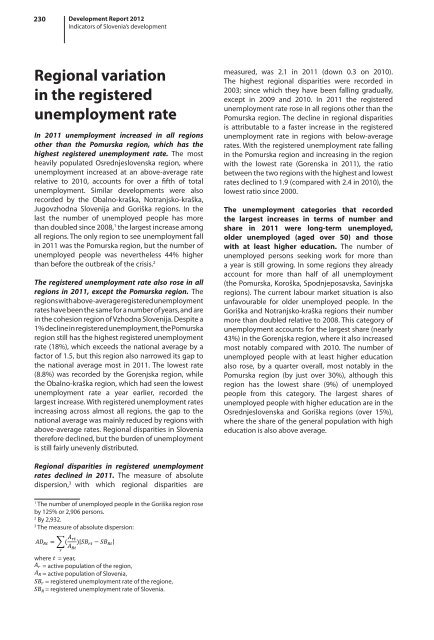development report 2012 - UMAR
development report 2012 - UMAR
development report 2012 - UMAR
You also want an ePaper? Increase the reach of your titles
YUMPU automatically turns print PDFs into web optimized ePapers that Google loves.
230 Development Report <strong>2012</strong><br />
Indicators of Slovenia’s <strong>development</strong><br />
Regional variation<br />
in the registered<br />
unemployment rate<br />
In 2011 unemployment increased in all regions<br />
other than the Pomurska region, which has the<br />
highest registered unemployment rate. The most<br />
heavily populated Osrednjeslovenska region, where<br />
unemployment increased at an above-average rate<br />
relative to 2010, accounts for over a fifth of total<br />
unemployment. Similar <strong>development</strong>s were also<br />
recorded by the Obalno-kraška, Notranjsko-kraška,<br />
Jugovzhodna Slovenija and Goriška regions. In the<br />
last the number of unemployed people has more<br />
than doubled since 2008, 1 the largest increase among<br />
all regions. The only region to see unemployment fall<br />
in 2011 was the Pomurska region, but the number of<br />
unemployed people was nevertheless 44% higher<br />
than before the outbreak of the crisis. 2<br />
The registered unemployment rate also rose in all<br />
regions in 2011, except the Pomurska region. The<br />
regions with above-average registered unemployment<br />
rates have been the same for a number of years, and are<br />
in the cohesion region of Vzhodna Slovenija. Despite a<br />
1% decline in registered unemployment, the Pomurska<br />
region still has the highest registered unemployment<br />
rate (18%), which exceeds the national average by a<br />
factor of 1.5, but this region also narrowed its gap to<br />
the national average most in 2011. The lowest rate<br />
(8.8%) was recorded by the Gorenjska region, while<br />
the Obalno-kraška region, which had seen the lowest<br />
unemployment rate a year earlier, recorded the<br />
largest increase. With registered unemployment rates<br />
increasing across almost all regions, the gap to the<br />
national average was mainly reduced by regions with<br />
above-average rates. Regional disparities in Slovenia<br />
therefore declined, but the burden of unemployment<br />
is still fairly unevenly distributed.<br />
measured, was 2.1 in 2011 (down 0.3 on 2010).<br />
The highest regional disparities were recorded in<br />
2003; since which they have been falling gradually,<br />
except in 2009 and 2010. In 2011 the registered<br />
unemployment rate rose in all regions other than the<br />
Pomurska region. The decline in regional disparities<br />
is attributable to a faster increase in the registered<br />
unemployment rate in regions with below-average<br />
rates. With the registered unemployment rate falling<br />
in the Pomurska region and increasing in the region<br />
with the lowest rate (Gorenska in 2011), the ratio<br />
between the two regions with the highest and lowest<br />
rates declined to 1.9 (compared with 2.4 in 2010), the<br />
lowest ratio since 2000.<br />
The unemployment categories that recorded<br />
the largest increases in terms of number and<br />
share in 2011 were long-term unemployed,<br />
older unemployed (aged over 50) and those<br />
with at least higher education. The number of<br />
unemployed persons seeking work for more than<br />
a year is still growing. In some regions they already<br />
account for more than half of all unemployment<br />
(the Pomurska, Koroška, Spodnjeposavska, Savinjska<br />
regions). The current labour market situation is also<br />
unfavourable for older unemployed people. In the<br />
Goriška and Notranjsko-kraška regions their number<br />
more than doubled relative to 2008. This category of<br />
unemployment accounts for the largest share (nearly<br />
43%) in the Gorenjska region, where it also increased<br />
most notably compared with 2010. The number of<br />
unemployed people with at least higher education<br />
also rose, by a quarter overall, most notably in the<br />
Pomurska region (by just over 30%), although this<br />
region has the lowest share (9%) of unemployed<br />
people from this category. The largest shares of<br />
unemployed people with higher education are in the<br />
Osrednjeslovenska and Goriška regions (over 15%),<br />
where the share of the general population with high<br />
education is also above average.<br />
Regional disparities in registered unemployment<br />
rates declined in 2011. The measure of absolute<br />
dispersion, 3 with which regional disparities are<br />
1<br />
The number of unemployed people in the Goriška region rose<br />
by 125% or 2,906 persons.<br />
2<br />
By 2,932.<br />
3<br />
The measure of absolute dispersion:<br />
<br />
|<br />
|<br />
<br />
<br />
where = year,<br />
= active population of the region,<br />
= active population of Slovenia,<br />
= registered unemployment rate of the regione,<br />
= registered unemployment rate of Slovenia.
















